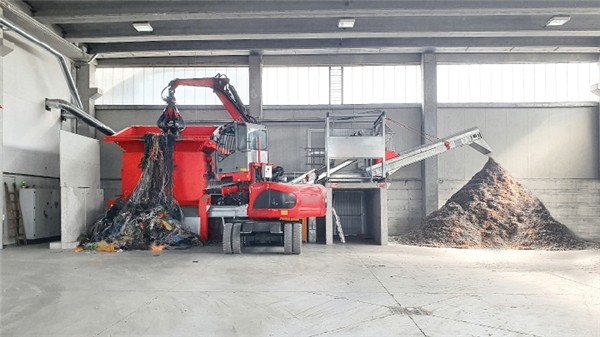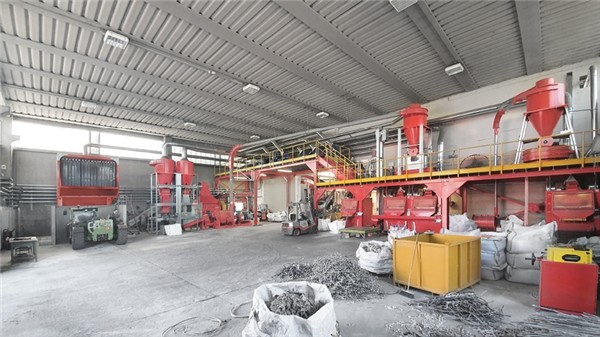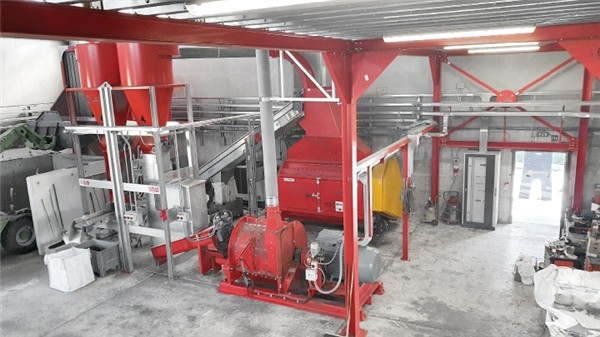Sensor-based selection systems have become essential in large-scale processing of electronic waste-Newberry Metal Recycling Limited
Technology Frequently Employed for the Isolation of Metal Mixes after Eddy Current Separation.
A manufactured optical Selector and Its Feeding Mechanism Utilized by UK Greater Manchester’s Newberry metal recycling limited in Electronic Scrap selecting operations.
Sensor-based selection systems have become essential in large-scale processing of electronic waste. These systems are especially adept at isolating nonferrous metal blends from the stream of materials typically found following an eddy current separation. These sorting solutions can meticulously retrieve even the finest strands of copper, effectively diminishing the presence of metals in the resultant plastics mix.

A common procedure in the recycling of electronic components is to amalgamate circuit board contents with wire residues. This usually takes place as an additional step post the initial extraction of nonferrous materials. To achieve the segregation of these composite materials, a recycling facility must utilize a versatile sensor-based selection apparatus, equipped with both electromagnetic and optical (near-infrared/visible) detection capabilities.
The segregation of plastics tends to occur through a “negative selection” process, whereby they are what remain after the valuable metal elements have been extracted. This resulting mix of plastic polymers is typically transported as a heterogeneous blend.
The task of separating different plastics from the fragmented debris of discarded electronics using sensor-based selectors is complex: accurate sorting with near-infrared technology is effective mainly for non black plastics. Although there are sophisticated optical selection systems commercially available that can differentiate between black plastics based on their polymer make-up, they too have their own set of limitations. The various filler substances utilized in black plastics complicate their recycling process. Nevertheless, despite these obstacles in plastic sorting, the effectiveness of sensor-based selection for nonferrous metal recovery underpins its essential role in any high-capacity electronic waste shredding facility: these systems often generate the most considerable income for the operation.

The effectiveness of sensor-based selection equipment is heavily reliant on appropriate material preparation.
Effective material preparation is essential for the success of these sensor-based machines. Proper liberation of the material using the right shredding technology and ensuring the material is presented in a single layer and well-distributed on the belt is crucial for optimizing the performance of the optical selection and reducing collateral damage. This helps to enhance the optical selectors ability to survey the belt and reduce the likelihood of ejecting unintended materials.
Technology Frequently Employed for the Isolation of Metal Mixes after Eddy Current Separation.
A manufactured optical Selector and Its Feeding Mechanism Utilized by UK Greater Manchester’s Newberry metal recycling limited in Electronic Scrap selecting operations.
Sensor-based selection systems have become essential in large-scale processing of electronic waste. These systems are especially adept at isolating nonferrous metal blends from the stream of materials typically found following an eddy current separation. These sorting solutions can meticulously retrieve even the finest strands of copper, effectively diminishing the presence of metals in the resultant plastics mix.
A common procedure in the recycling of electronic components is to amalgamate circuit board contents with wire residues. This usually takes place as an additional step post the initial extraction of nonferrous materials. To achieve the segregation of these composite materials, a recycling facility must utilize a versatile sensor-based selection apparatus, equipped with both electromagnetic and optical (near-infrared/visible) detection capabilities.
The segregation of plastics tends to occur through a “negative selection” process, whereby they are what remain after the valuable metal elements have been extracted. This resulting mix of plastic polymers is typically transported as a heterogeneous blend.
The task of separating different plastics from the fragmented debris of discarded electronics using sensor-based selectors is complex: accurate sorting with near-infrared technology is effective mainly for non black plastics. Although there are sophisticated optical selection systems commercially available that can differentiate between black plastics based on their polymer make-up, they too have their own set of limitations. The various filler substances utilized in black plastics complicate their recycling process. Nevertheless, despite these obstacles in plastic sorting, the effectiveness of sensor-based selection for nonferrous metal recovery underpins its essential role in any high-capacity electronic waste shredding facility: these systems often generate the most considerable income for the operation.
The effectiveness of sensor-based selection equipment is heavily reliant on appropriate material preparation.
Effective material preparation is essential for the success of these sensor-based machines. Proper liberation of the material using the right shredding technology and ensuring the material is presented in a single layer and well-distributed on the belt is crucial for optimizing the performance of the optical selection and reducing collateral damage. This helps to enhance the optical selectors ability to survey the belt and reduce the likelihood of ejecting unintended materials.

英国大曼彻斯特的Newberry 金属再生资源有限公司在电子废料分选操作中使用了制造的光学选择器及其进料机构。
基于传感器的选择系统在电子废物的大规模处理中已变得至关重要,这些系统特别擅长从涡流分离后通常发现的材料流中分离有色金属混合物,甚至可以精心回收最细的铜线,从而有效减少最终塑料混合物中金属的存在。
电子元件回收的常见程序是将电路板内容物与电线残留物合并,通常作为有色金属材料初始提取后的附加步骤进行。为了实现这些复合材料的分离,回收设施必须使用基于传感器的多功能选择装置,并配备电磁和光学(近红外/可见光)检测功能。
塑料的分离往往是通过“负选择”过程发生的,即在提取有价值的金属元素后留下的塑料。 由此产生的塑料聚合物混合物通常作为异质混合物进行运输。
使用基于传感器的选择器从废弃电子产品的碎片中分离不同的塑料的任务很复杂:利用近红外技术进行精确分选主要对非黑色塑料有效。
尽管市面上有先进的光学选择系统可以根据聚合物成分区分黑色塑料,但它们也有其自身的局限性。黑色塑料中使用的各种填充物质使它们的回收过程变得复杂。
然而,尽管塑料分选存在这些障碍,基于传感器的有色金属回收选择的有效性支撑了其在任何高容量电子废物粉碎设施中的重要作用:这些系统通常为运营带来最可观的收入。基于传感器的选择设备的有效性在很大程度上依赖于适当的材料制备。有效的材料准备对于这些基于传感器的机器的成功至关重要。
使用正确的粉碎技术正确释放材料并确保材料以单层形式呈现并均匀分布在传送带上,对于优化光学选择的性能和减少附带损坏至关重要。这有助于增强光学选择器测量传送带的能力并减少弹出意外材料的可能性。
郑重声明:此文内容为本网站转载企业宣传资讯,目的在于传播更多信息,与本站立场无关。仅供读者参考,并请自行核实相关内容。


